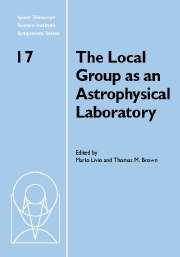 The Local Group as an Astrophysical Laboratory
The Local Group as an Astrophysical Laboratory Published online by Cambridge University Press: 12 May 2010
The Space Telescope Science Institute Symposium on “The Local Group as an Astrophysical Laboratory” took place during 5–8 May 2003.
The Local Group is in some sense the universe in a nutshell. The processes of galaxy mergers and interactions are the bread and butter of hierarchical structure formation. These processes can be studied in unsurpassed detail in the Local Group. Starburst regions in the LMC provide spectacular local versions of their high-redshift counterparts. While black holes are believed to reside at the centers of most galaxies, the best determination of the mass of a central black hole has been achieved in our own Galaxy (through the orbits of individual stars). In addition, the Local Group provides a rich census of star formation histories and of stellar populations. In short, before we attempt to understand the Universe, understanding our own backyard is a good start.
These proceedings represent only a part of the invited talks that were presented at the symposium. We thank the contributing authors for preparing their manuscripts.
We thank Sharon Toolan of ST ScI for her help in preparing this volume for publication.
To save this book to your Kindle, first ensure [email protected] is added to your Approved Personal Document E-mail List under your Personal Document Settings on the Manage Your Content and Devices page of your Amazon account. Then enter the ‘name’ part of your Kindle email address below. Find out more about saving to your Kindle.
Note you can select to save to either the @free.kindle.com or @kindle.com variations. ‘@free.kindle.com’ emails are free but can only be saved to your device when it is connected to wi-fi. ‘@kindle.com’ emails can be delivered even when you are not connected to wi-fi, but note that service fees apply.
Find out more about the Kindle Personal Document Service.
To save content items to your account, please confirm that you agree to abide by our usage policies. If this is the first time you use this feature, you will be asked to authorise Cambridge Core to connect with your account. Find out more about saving content to Dropbox.
To save content items to your account, please confirm that you agree to abide by our usage policies. If this is the first time you use this feature, you will be asked to authorise Cambridge Core to connect with your account. Find out more about saving content to Google Drive.